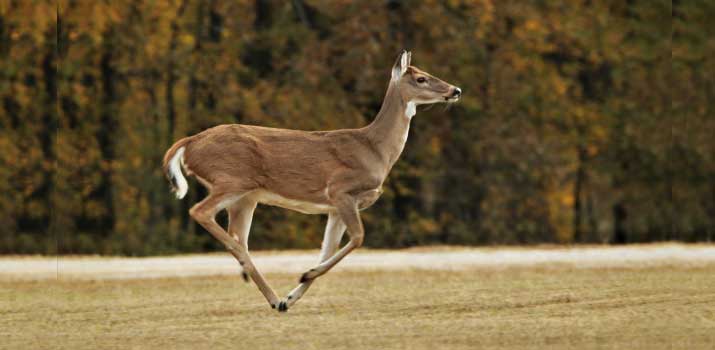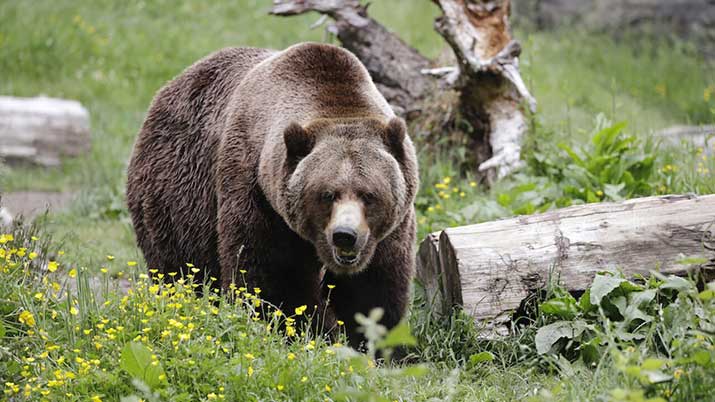You need only assess the whitetail deer’s natural predators to get a good idea of how fast these creatures are.
From cougars to bears to, well… us, they need to be able to outrun some bonafide speed demons if they’re to survive in their natural habitat.

Luckily for them, their species has already gone through millions of years of rigorous natural selection and adaptation, giving them the best possible chance of escaping danger when necessary.
Of course, just like humans, we have to take individual differences into account when contemplating the speed of an entire species of deer; we’re not all as quick as Usain Bolt after all!
But, generally speaking, when they’re really bucking it (pun definitely intended), it’s not unheard of for an adult whitetail to reach speeds of between 35 and 40 miles per hour — Pretty impressive, ay?
However, deer automatically know to conserve their energy, meaning they’ll rarely put their hoof to the metal and run all out.
These majestic animals enjoy a variety of gaits that permit travel at any speed up to the highest range possible in accordance with various factors, such as age, infirmity, and strength.
How Are Deer Able To Run So Quickly?
We’ve already touched upon natural selection, but let’s go into more detail about how it works and relates to the speed of modern day deer.
Let’s say there is a herd of deer foraging in the forest when, suddenly, a grizzly bear shows up (ahhh!).
The deer instinctively know that it’s time to run like hell, so off they go, bounding into the woods at top speed.
Now, the bear buffs out there will know that, despite their heft, these ferocious hunters are pretty quick on their feet too, so we’ve got a thrilling chase on our hands, but the bear needn’t catch up with the fastest of the herd, for as long as he catches one deer, it gets a hearty meal.
Speedy Genes Survive
So, the bear catches and kills the slowest member of the herd, thereby removing them from the gene pool, meaning they won’t be able to procreate and form more sluggish deer.
The fast deer that got away, on the other hand, procreate like crazy, passing down their super speedy genes to super speedy fawns.
Over time, this process creates highly specialized animals, perfectly designed to handle the rigors of their habitat.
Of course, the same thing is happening for our old friend the bear, so, in effect, what’s actually going on here is a perpetual evolutionary arms race.
Deer Physiology: What Allows Them To Run So Fast?
Natural selection is an astounding process, but let’s focus up on the outcome of this survival of the fittest lifestyle and uncover what specific aspects of deer physiology make them such rapid animals.
For any creature, speed is largely determined by muscle fibers, most of which fall into one of two categories:
- Type 1 muscle fibers — All slow twitch muscle fibers fall into the type 1 category. As they’re capable of providing small amounts of power over long periods before fatiguing, they’re considered an endurance fiber.
- Type 2 muscle fibers — As you might expect, type 2 muscle fibers, or fast twitch fibers, have the opposite ability, providing tons of energy really, really quickly, facilitating explosive movement over short periods.
According to research on the physiology of deer, these animals have both kinds of fibers in spades, but they have a truly extraordinary type two muscle fiber density, allowing them to cover some serious ground in very little time to escape danger.
However, maintaining such speed is another kettle of fish.
Studies have shown that the strongest whitetail deer are capable of running for 3–4 miles at an average speed of 30 miles per hour, but beyond that, exhaustion sets in and the deer may well collapse and die.
Could A Human Outrun A Whitetail Deer?
Humans are capable of some remarkable things, but running faster than a whitetail deer traveling at full speed isn’t one of them — Olympic sprinters don’t even hold a candle to these nimble creatures.
To put their speed into perspective for you, consider Usain Bolt’s fastest recorded sprint.
At the 67 meter stage of a 100 meter race, he reached 27.3 miles per hour (roughly 44 km/h).
As impressive as that is for a human, it’s still almost 13 miles per hour slower than a whitetail deer, and bear in mind that this wasn’t a sustainable speed for Bolt.
At all other points in the sprint, he was traveling much slower, amounting to an average race speed of 23.4 miles per hour (37.6 km/h).
While a deer will certainly tire after a while, it could maintain top speed for much longer than Bolt did.
Being that the average running speed of a human is around 6 miles per hour, and the fastest person to have ever lived tops out at 27.3 miles per hour, I think it’s fair to say that no human will ever be able to run faster than a whitetail deer.
If Deer Are So Fast, How Do Humans Hunt Them?
When hunting deer, modern firearms and tactical equipment give humans a massive advantage.
Marksmen can shoot accurately from a great distance, giving a deer very little chance of escaping with its life.
If the deer did register the presence of a hunter and bolted, there’s simply no way the human could keep up with it on foot, but here’s the thing… humans have an abundance of type 1 muscle fibers, meaning we’re built for endurance.
Our physiology makes us fantastic stalkers capable of traveling long distances while conserving most of our energy. This is why hunters track rather than chase deer.
Could A Horse Outrun A Deer?
Most horses can reach about 30 miles per hour at full gallop, so the average adult deer is almost always going to be faster than a wild horse, but horses that have been bred for speed for generations are a different story.
Many racehorses can break the 40 miles per hour threshold, with the current world records held by Winning Brew who ran at 43.97 miles per hour over a quarter mile distance, and Hawkster who ran at 37.82 miles per hour over one and a half miles.
Both these horses exhibited faster top speeds than we understand deer to be capable of and maintained these speeds for a much longer distance too.
So, as far as we know, horses are indeed faster than whitetail deer, but it’s worth mentioning that the speed of all racehorses is recorded frequently, while deer are never given an opportunity to have their pace measured in such an empirical fashion.
Which Are Faster, Deer Or Bears?
Grizzly bears typically top out around the 35 miles per hour mark, which is plenty fast enough to catch slower deer on land, especially over an open expanse when a deer’s agility isn’t going to be of much use.

Grizzlies also have better endurance than deer, so if they can keep their prey in sight, deer is almost certainly on the menu.
However, if there’s a body of water nearby, the deer might have a fighting chance of survival.
Not many people realize it, but deer are skillful swimmers, capable of reaching speeds of up to 15 miles per hour, while grizzlies can only swim at around 6 miles per hour, which is about the same as the best human swimmers.
Can A Deer Outrun A Dog?
On average, deer are faster than dogs, who will typically only be able to reach around 20 miles per hour, but if we disregard averages and focus on the snappiest dog species, deer don’t fare so well.
In areas where hunting deer with dogs is still legal, most choose Labrador retrievers to accompany them, as they have a top speed of roughly 35 miles per hour.
This Meand they can keep up with a lot of deer, and being that they have a greater abundance of slow twitch muscle fibers, they can easily tire deer out over long distances.
With a top speed of about 43 miles per hour, greyhounds are even faster, but as they’re primarily bred for racing, it’s unheard of for them to accompany humans on a hunt.
Are Cougars Faster Than Deer?
Cougars are some quick customers! Capable of reaching between 40 and 50 miles an hour over short distances, they’re technically faster than deer.
Cougars will use their bursts of energy to charge at unsuspecting deer at full pelt, hoping to catch one before they flee.
Should this gamble fail, the superior endurance of deer allows them to get away with relative ease.
Can Wolves Catch Whitetail Deer?
Wolves have certainly been known to hunt deer, and as they can hit speeds of 35 miles per hour, they could almost go toe to toe with their prey if it came down to a full-blown sprint, but only for a short while.
In order to maintain pace over longer distances, wolves have to hit the brakes, bringing their speed down to about 20 miles per hour, which isn’t quick enough to keep up with deer, but wolves are clever creatures and adept hunters.
They understand that deer have them beat in the pace department, so they employ cunning pack tactics to fell their prey instead.
How Fast Are Whitetail Deer Compared To Other Deer Species?
Whitetail are one of the fastest deer species on the planet, and that’s no mean feat considering there are 43 different species out there (well a couple are extinct, but you get the point).
Are they the fastest deer species overall? No, not quite, but they’re not far off.
Eurasian roe deer are about the same speed, some elk are known to be able to reach speeds of up to 45 miles per hour, as can mule deer, and it’s not unheard of for reindeer to trump all four species with brief 50 mph bursts.
Are Deer Faster Than Pronghorn?
As a species of antelope, it’s no surprise that pronghorn are wickedly fast animals.
Capable of traveling at 60 miles per hour over short distances and 30 miles per hour almost indefinitely, pronghorn have whitetail deer well and truly beat.
A land animal traveling at these speeds seems utterly otherworldly, but considering the roster of predators antelope contend with on a day-to-day basis, it all starts to make a little more sense — We’re talking cheetahs (50–80 mph), hyenas (40 mph), lions (50 mph), leopards (40 mph), and civets (40 mph).
What Terrain Are Deer Fastest In?
Open landscapes with steady terrain offer animals the best chance to show off their pace, but where deer really excel is dense forestry, as they can put their agility to good use, dodging obstacles at high speed.
They won’t be able to travel quite as fast through woodland as they would an open space, but as long as the obstacles in their path don’t slow them down as much as their predators, the deer will have the last laugh.
As mentioned earlier, deer are also surprisingly aquadynamic, which is part of the reason they’ll often bed down near large bodies of water.
In these spots, they can drink whenever they need, and if a predator is closing in on them, they can take to the water and zoom off to safety.
Final Thoughts
Capable of running up to 40 miles per hour, whitetail deer are among the fastest of all deer species on the planet, and by reducing their speed by only 10 miles per hour, they can maintain a steady pace for 3–4 miles, giving them a good chance of avoiding predation.
Their only natural predator capable of keeping up with them is the cougar which can travel at speeds of up to 50 miles per hour but only for very short bursts.
If the cougar fails to bring a deer down quickly using its lightning-fast yet short-lived pace, there’s a good chance the deer will live to tell the tail.
